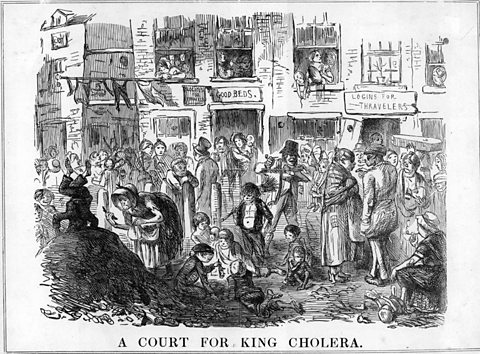Cholera and typhoid
Cholera and typhoid were serious diseases that thrived in the unhygienic living conditions of 19th-century towns.
Cholera
Cholera first appeared in Britain in 1831, on board a boat from India. Thus, like the Black Death, it came by sea and caused a similar level of fear in people.
Cholera is a bacterial infection caused by contaminated food or water. It thrived in Britainâs industrial towns. It caused vomiting and diarrhoea, and could result in death within a matter of hours. No one knew what caused it, which was what made it so frightening. Various causes were suggested, such as poisonous air, drunkenness and indecent behaviour.
A cholera epidemicAn infectious disease which spreads rapidly to a large number of people in a short period of time. in 1831-32 claimed 50,000 lives across the UK. London suffered the worst, with 5,000 deaths. In Glasgow, Scotland, 3,000 people died. Merthyr Tydfil, in Wales, had 160 deaths. Birmingham, Manchester, Newcastle, and many other towns and cities in England were also affected with high case numbers.
A second epidemic occurred in 1848, causing 52,000 more deaths. In London alone, 14,137 people died from cholera. Other cities suffered badly as well, including Liverpool with 5,308 deaths and Hull with 1,834 deaths.
A third epidemic hit Britain in 1854, but this time only 23,000 people died. It was during this epidemic that Dr John Snow finally made the link between cholera and contaminated water supplies. The building of sewerage systems and clean water supplies in the late 19th century greatly reduced the risk from cholera.

Typhoid
Typhoid is another bacterial infection that spreads through contaminated food and water. In the 19th century, it was caused by poor sanitation and lack of cleanliness, eg not washing hands and clothes.
It develops more slowly than cholera, but it can also be fatal. Between the 1830s and 1860s, typhoid claimed many lives across England and Wales, particularly among the poor. In London alone, there were 16,000 cases a year between 1838 and 1842.
During an outbreak of typhoid in Wales in 1882, 42 people died in Bangor. The clothes and bedding of the dead were burned, though this did nothing to end the outbreak. The local health board insisted that miasmaSmells from decomposing material, such as animal and human waste, that were thought to cause disease. were the reason for the outbreak. In fact, the cause was contaminated water from a farm, which entered the newly built reservoir that brought clean water to Bangor.
In 1884, the Typhus bacillus bacterium was identified. Since then, a combination of better sanitation and hygiene has reduced the risk of typhoid. However, there are still occasionally cases today.
By the end of the 19th century, knowledge of what caused disease and illness had improved considerably. Improvements under the public health acts, vaccination for diseases like smallpoxSerious illness caused by a virus. Smallpox gets its name from the pus-filled blisters (or pocks) that form during the illness. and better personal hygiene had helped to combat illness and disease. However, many problems remained.